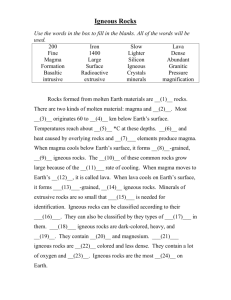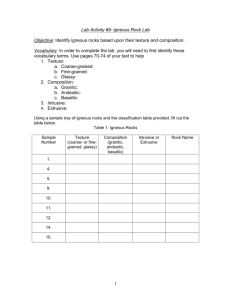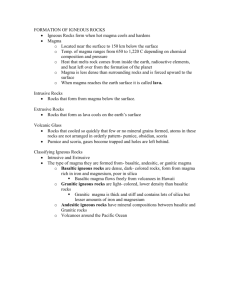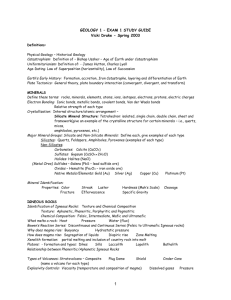Chapter 5 Answer Keys
advertisement
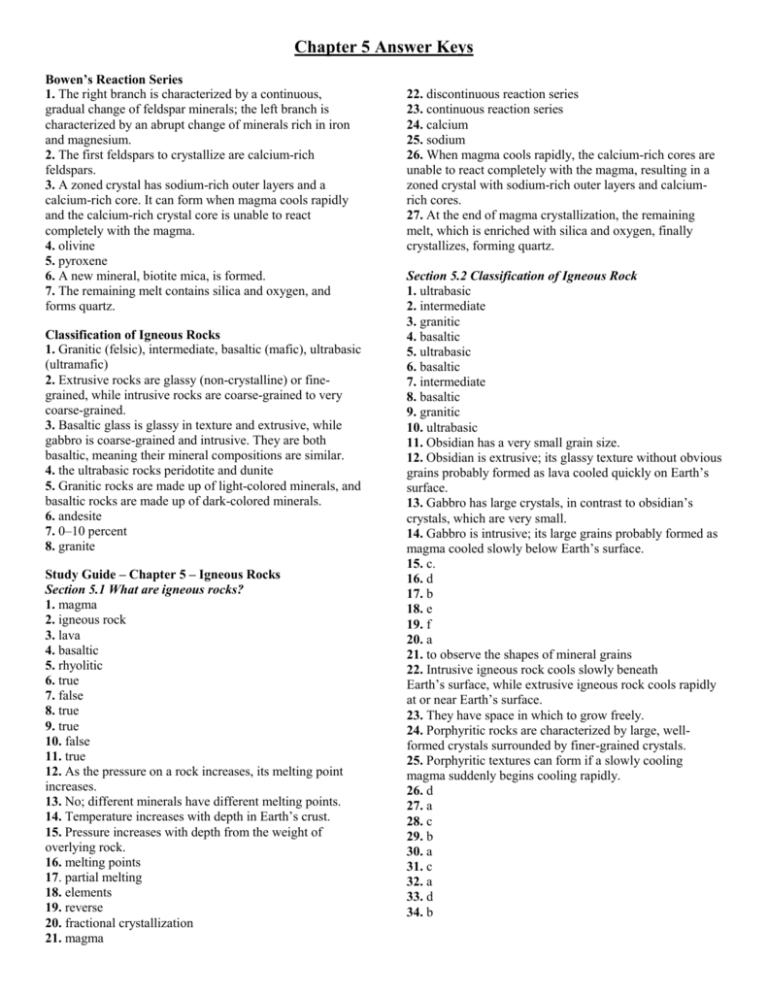
Chapter 5 Answer Keys Bowen’s Reaction Series 1. The right branch is characterized by a continuous, gradual change of feldspar minerals; the left branch is characterized by an abrupt change of minerals rich in iron and magnesium. 2. The first feldspars to crystallize are calcium-rich feldspars. 3. A zoned crystal has sodium-rich outer layers and a calcium-rich core. It can form when magma cools rapidly and the calcium-rich crystal core is unable to react completely with the magma. 4. olivine 5. pyroxene 6. A new mineral, biotite mica, is formed. 7. The remaining melt contains silica and oxygen, and forms quartz. Classification of Igneous Rocks 1. Granitic (felsic), intermediate, basaltic (mafic), ultrabasic (ultramafic) 2. Extrusive rocks are glassy (non-crystalline) or finegrained, while intrusive rocks are coarse-grained to very coarse-grained. 3. Basaltic glass is glassy in texture and extrusive, while gabbro is coarse-grained and intrusive. They are both basaltic, meaning their mineral compositions are similar. 4. the ultrabasic rocks peridotite and dunite 5. Granitic rocks are made up of light-colored minerals, and basaltic rocks are made up of dark-colored minerals. 6. andesite 7. 0–10 percent 8. granite Study Guide – Chapter 5 – Igneous Rocks Section 5.1 What are igneous rocks? 1. magma 2. igneous rock 3. lava 4. basaltic 5. rhyolitic 6. true 7. false 8. true 9. true 10. false 11. true 12. As the pressure on a rock increases, its melting point increases. 13. No; different minerals have different melting points. 14. Temperature increases with depth in Earth’s crust. 15. Pressure increases with depth from the weight of overlying rock. 16. melting points 17. partial melting 18. elements 19. reverse 20. fractional crystallization 21. magma 22. discontinuous reaction series 23. continuous reaction series 24. calcium 25. sodium 26. When magma cools rapidly, the calcium-rich cores are unable to react completely with the magma, resulting in a zoned crystal with sodium-rich outer layers and calciumrich cores. 27. At the end of magma crystallization, the remaining melt, which is enriched with silica and oxygen, finally crystallizes, forming quartz. Section 5.2 Classification of Igneous Rock 1. ultrabasic 2. intermediate 3. granitic 4. basaltic 5. ultrabasic 6. basaltic 7. intermediate 8. basaltic 9. granitic 10. ultrabasic 11. Obsidian has a very small grain size. 12. Obsidian is extrusive; its glassy texture without obvious grains probably formed as lava cooled quickly on Earth’s surface. 13. Gabbro has large crystals, in contrast to obsidian’s crystals, which are very small. 14. Gabbro is intrusive; its large grains probably formed as magma cooled slowly below Earth’s surface. 15. c. 16. d 17. b 18. e 19. f 20. a 21. to observe the shapes of mineral grains 22. Intrusive igneous rock cools slowly beneath Earth’s surface, while extrusive igneous rock cools rapidly at or near Earth’s surface. 23. They have space in which to grow freely. 24. Porphyritic rocks are characterized by large, wellformed crystals surrounded by finer-grained crystals. 25. Porphyritic textures can form if a slowly cooling magma suddenly begins cooling rapidly. 26. d 27. a 28. c 29. b 30. a 31. c 32. a 33. d 34. b




